Special Report
The Climate Crisis Will Permanently Change How These 22 Crops Are Grown
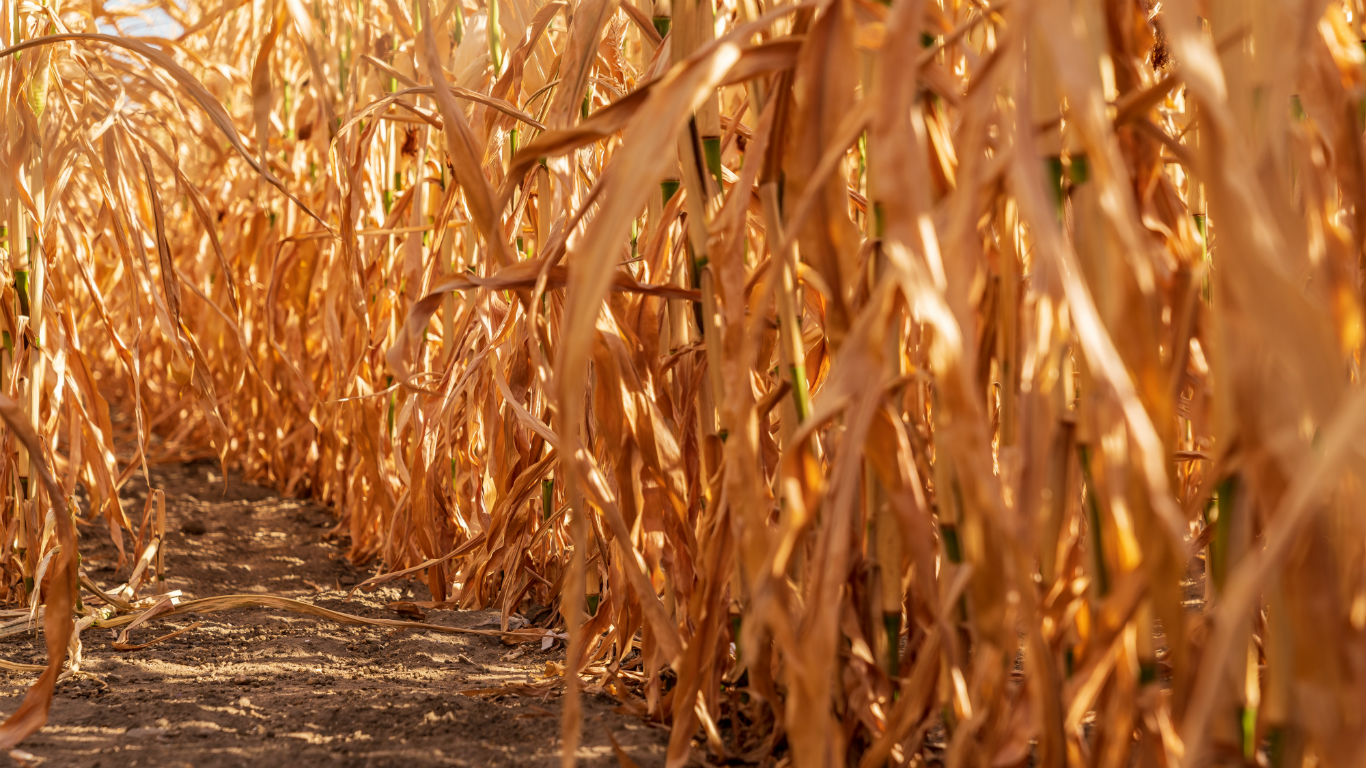
Published:
Last Updated:

Climate change is already transforming crop production worldwide, and studies indicate that predicted changes in climate will have a severe impact on crop yields and food security in the future. As crops suffer from higher temperatures, changes in precipitation patterns, and severe weather events, the availability, cost, safety, and quality of food supplies are all likely to suffer.
For many crops and in many regions of the world, adaptive measures can be taken to avoid or limit the negative impact of climate change on crops. Crops suffering from temperature increases, flooding, and sea level rise can be managed differently or moved to higher ground or to lands more conducive to successful crop production.
Growers and scientists are also having some success in modifying the genetic makeup of some crops, making them more resilient to extreme weather events and climate changes. And the most vulnerable crops can in some cases be replaced with more resilient crops that offer equivalent nutritional and economic value.
As the agricultural sector works to adapt to climate change, people already suffering from poverty will experience the most profound and negative impacts. Crop production in developing countries, which tend to be in tropical and subtropical regions and are home to the poorest populations in the world, will suffer the most. These are the poorest countries in the world.
Flooding, temperature extremes, fluctuations in precipitation, and extreme weather are already taking their toll, and will get worse, posing an existential threat to these regions. Jobs and economic vitality will be lost, food supplies will diminish, and, for many, the cost of adaptation will be prohibitive.
24/7 Wall St. reviewed some of the world’s most important crops and how they and the people who rely on them might be affected by climate change.
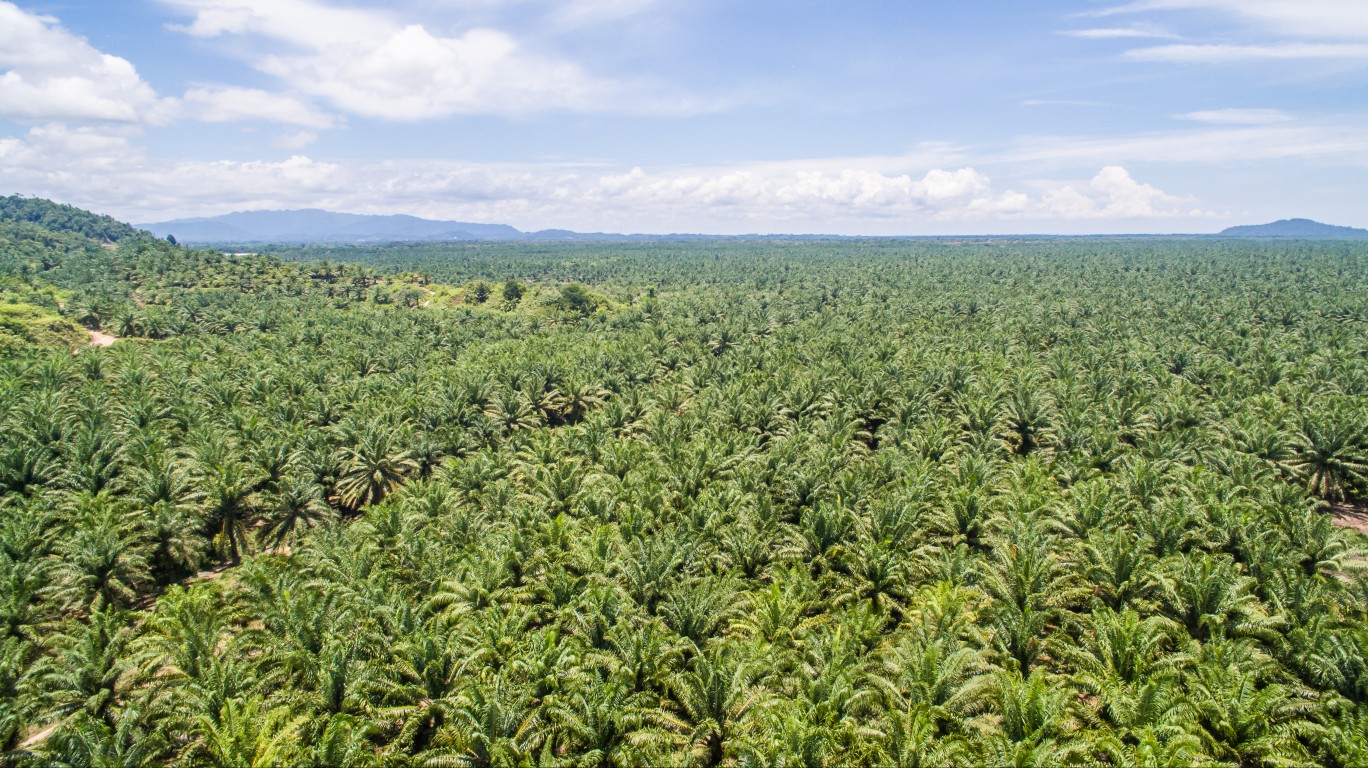
1. Oil palm
Palm oil production will be profoundly reduced because of climate change. Higher temperatures and lower rainfall are already causing significant reductions in yields in Malaysia, and predicted increases in flooding events will reduce production in Brazil, the Demoratic Republic of Congo, Indonesia, Peru, and Columbia. Ironically, palm oil production, a $50 billion global industry, is credited with large amounts of greenhouse gas emissions as tropical forests have been converted to plantations.
[in-text-ad]
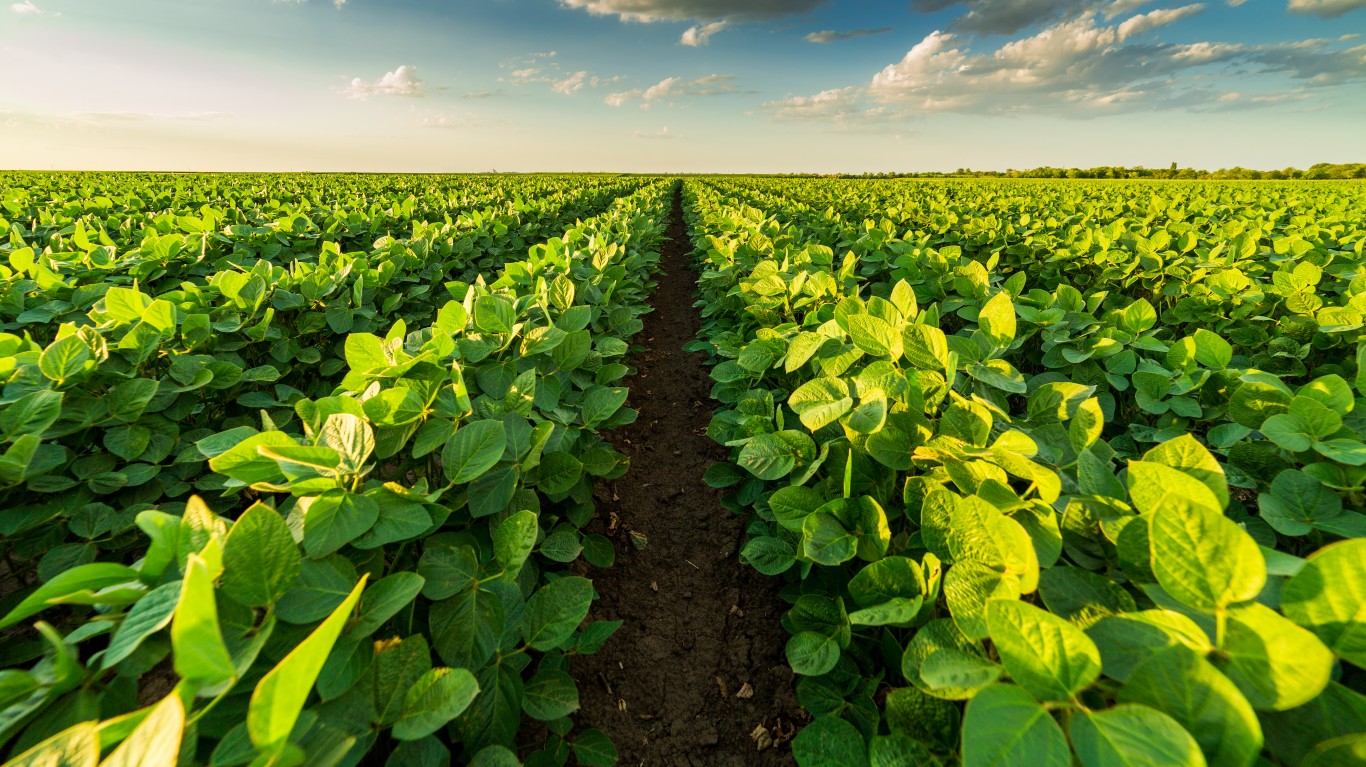
2. Soybean
Climate change appears to be having a positive impact on soybean yields and production in some parts of the world, particularly the Americas, but it is negatively affecting soybean crops in Europe, sub-Saharan Africa, Asia, and Pacific islands.
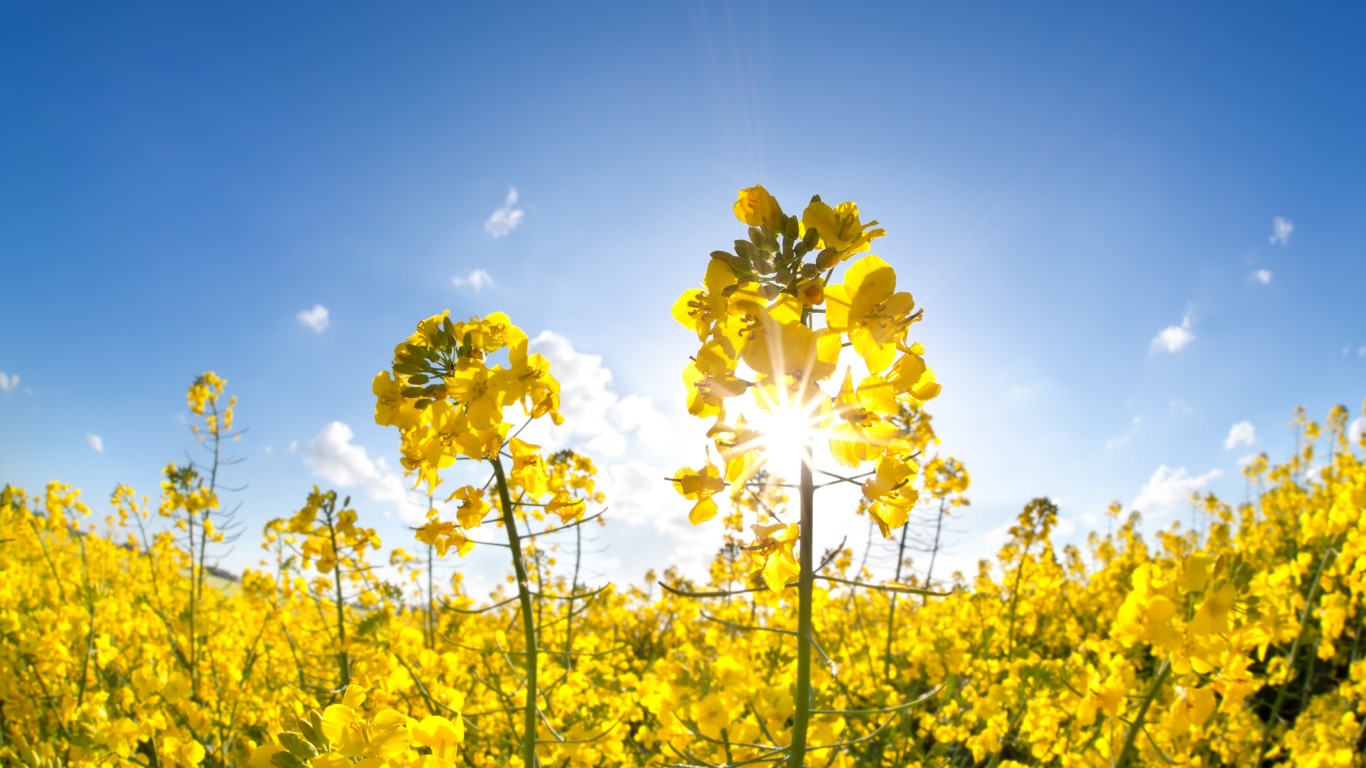
3. Rapeseed
With rising temperatures and predicted increases in prolonged heatwaves, rapeseed (canola) production is expected to suffer. So far, rapeseed production has not been significantly affected by climate change in most parts of the world, but in Southern and Western Europe rapeseed crops have suffered, mainly due to increased aridity — higher temperatures and reduced precipitation.
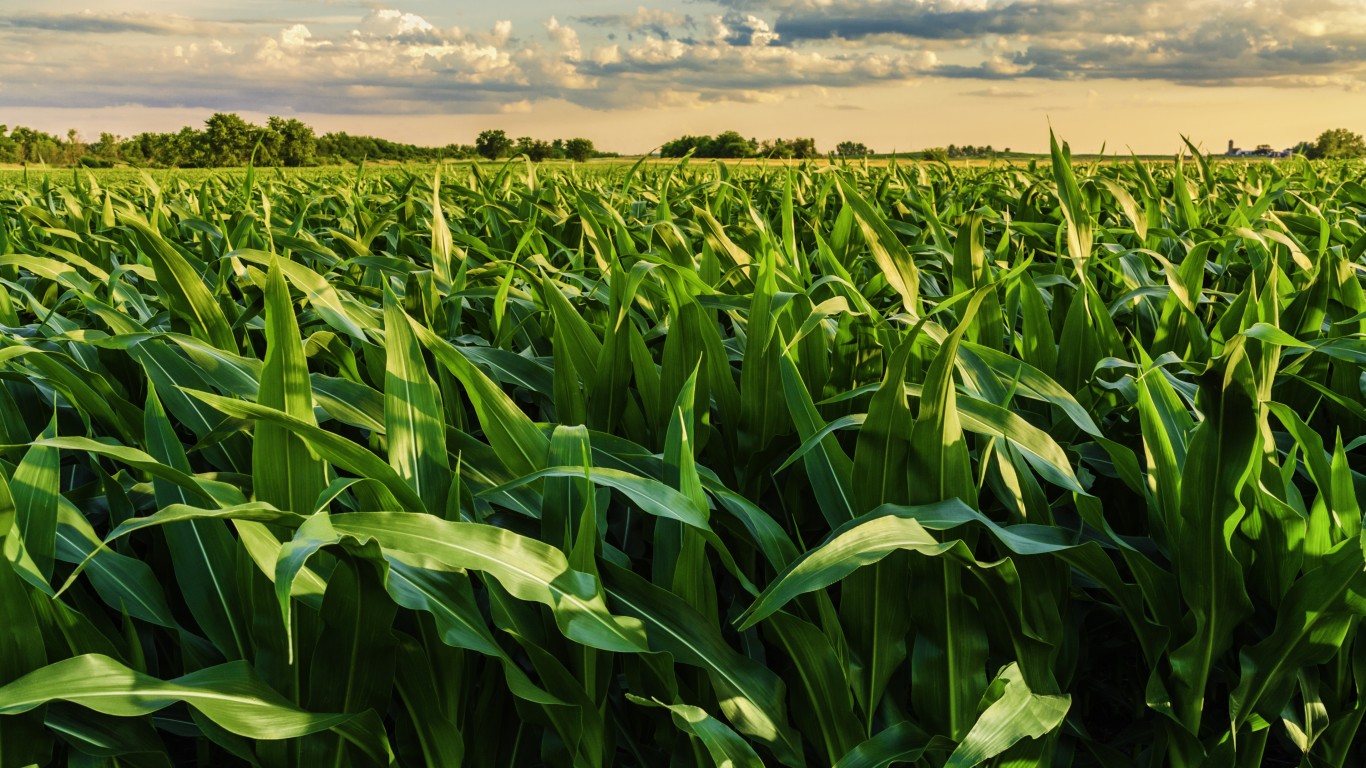
4. Corn
Corn is the world’s largest crop in terms of both production and trade, but by the end of the century, climate change could reduce U.S. corn production by half. It could also greatly increase the chances that the four biggest corn exporters — the United States, Brazil, Argentina, and Ukraine — will experience simultaneous corn yield losses of 10% or more. As temperatures rise, it is expected that corn yields will decline by 7.4% worldwide for every 1 degree Celsius increase in average temperature. Yields have already been significantly reduced throughout Europe, Africa, and the pacific islands, with some minor increases in the Americas and Asia.
[in-text-ad-2]
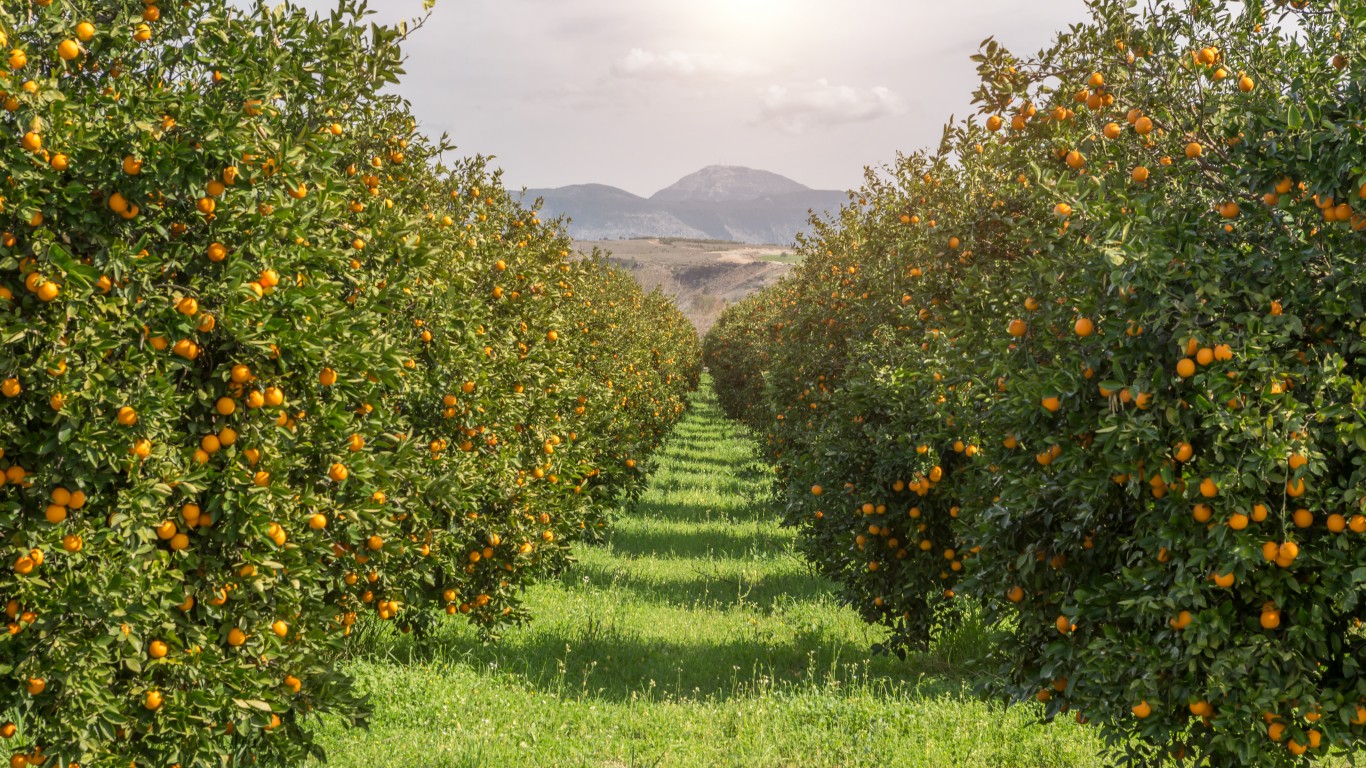
5. Oranges
As for most crops, threats from climate change on orange production depend on regional conditions. In the Mediterranean, for example, the production and quality of citrus fruit is expected to decline because of increases in temperatures and reduced precipitation. In Florida, where yields have been significantly below USDA predictions, orange crops will suffer from extreme weather events and weather fluctuations.
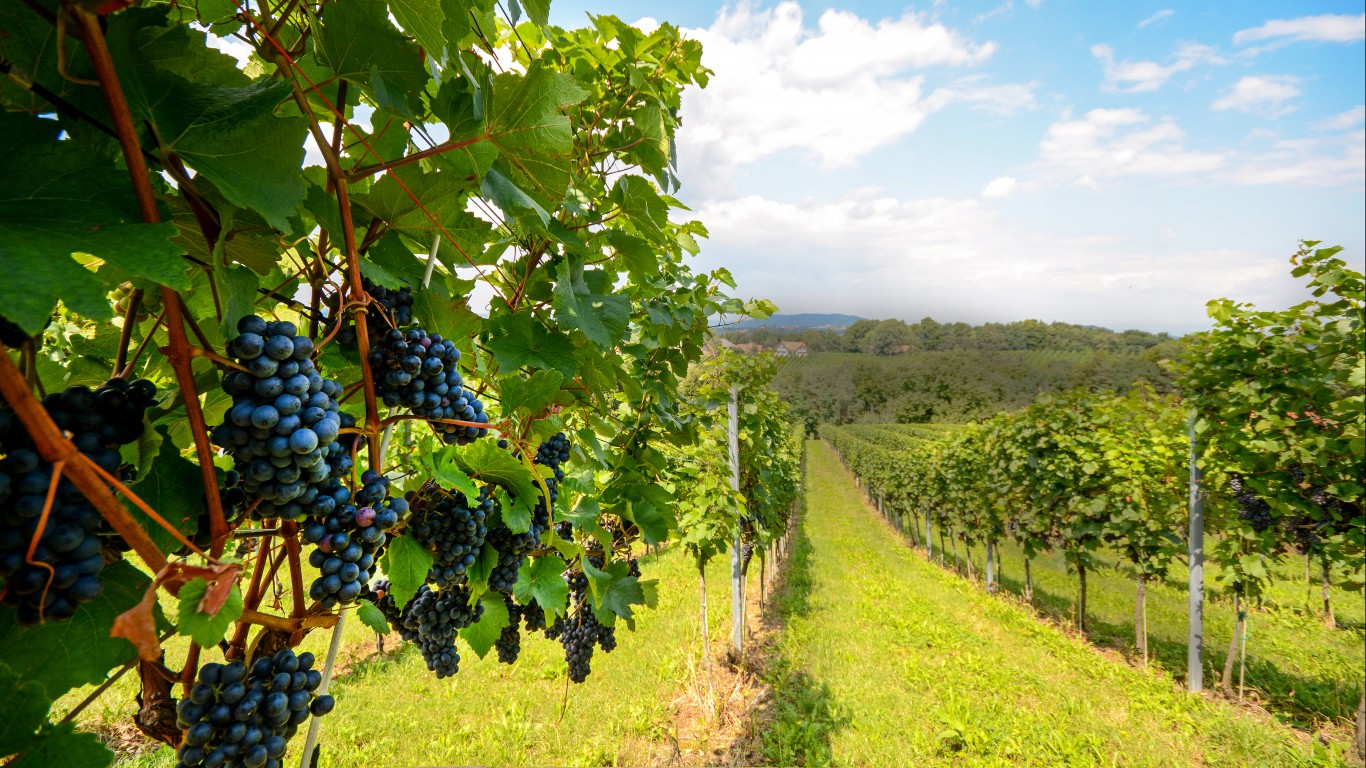
6. Wine grapes
The effect of climate change on wine grape will depend on how strictly growers will continue to adhere to the concept of terroir, which means a wine flavor reflects the local geography and the unique types of grapes fit to grow in that particular wine region. Because historic wine making regions have traditionally grown specific grape varieties, climate change will be extremely disruptive as terroir changes with temperature and rainfall fluctuations. Because of the great diversity in wine grape varieties, wine growers who are willing to let go of traditional and beloved varietals and experiment with others that are more likely to survive.
[in-text-ad]
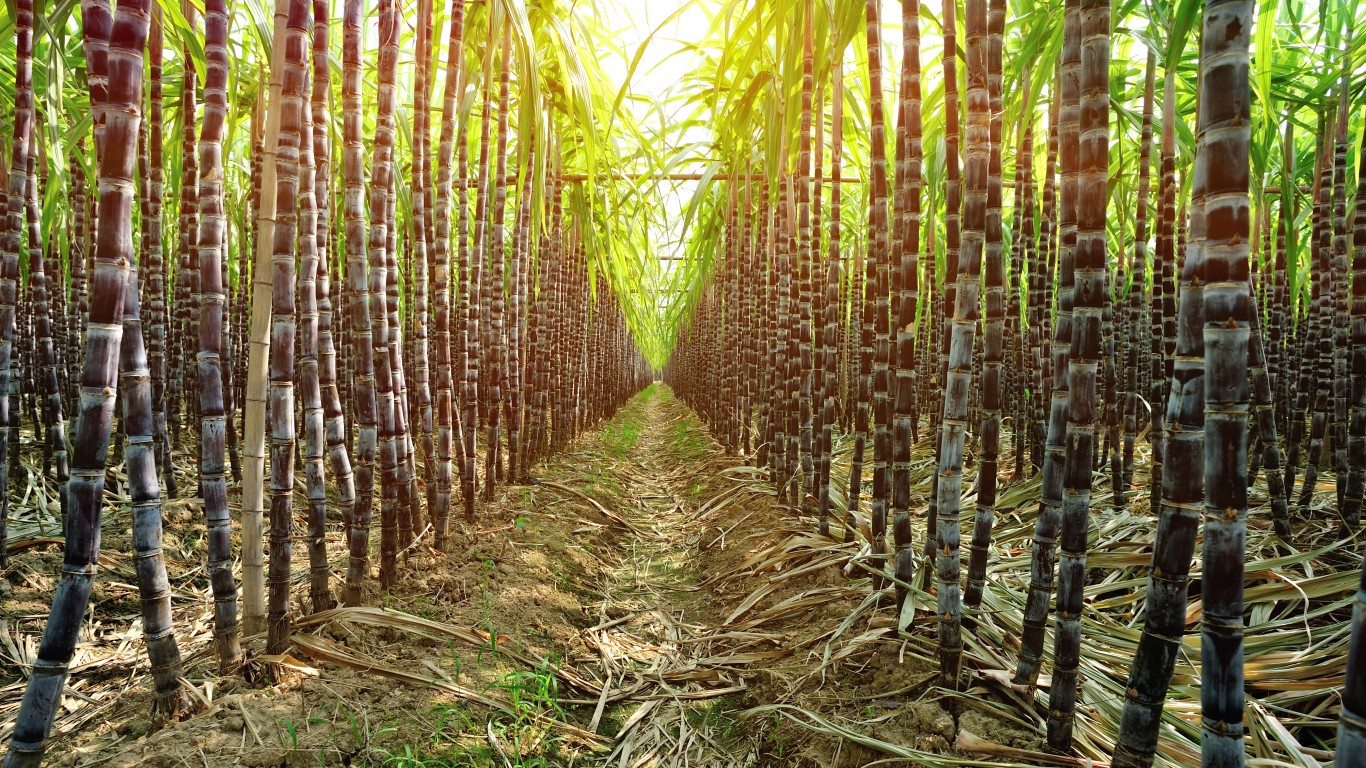
7. Sugarcane
The scientific community’s understanding of the impact of climate change on crops is evolving. Australian researchers last year undertook a comprehensive review of existing research on the effects of climate change on sugarcane production worldwide. Still, they were unable to draw conclusions because of different environmental conditions within regions and changing management practices. Another study published last year, however, used 34 years of data to find that, thus far, climate change appears to have had a very positive effect on sugarcane yields and production in Europe and the western hemisphere and a very negative effect in Africa and Asia.
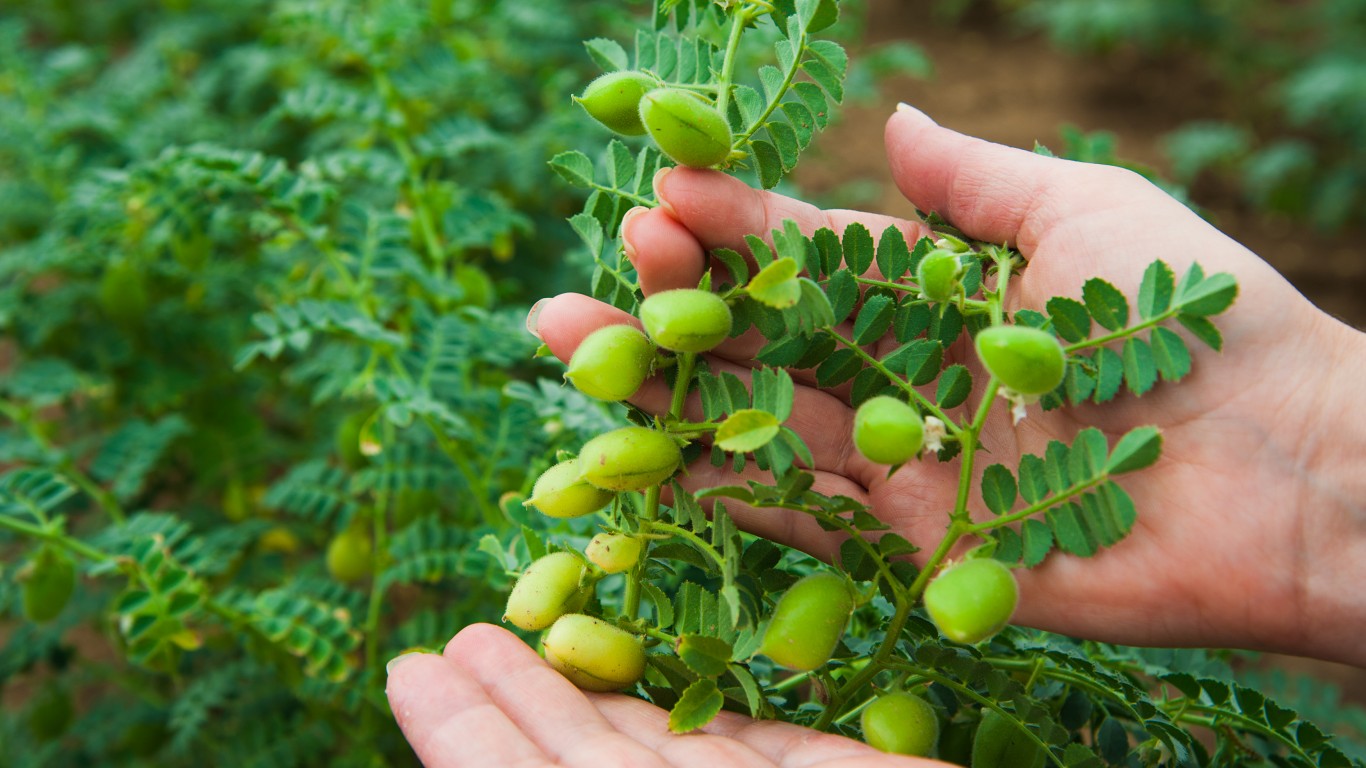
8. Chickpeas
Chickpeas are an important source of protein in many developing countries, particularly India, which grows millions of tons of chickpeas a year and still relies on imports, mainly from Australia. Because it is critical to food security, it is important that chickpea production adapts to the threats posed by climate change in growing regions. Scientists are working with farmers to develop drought, disease, and salinity resistant strains.
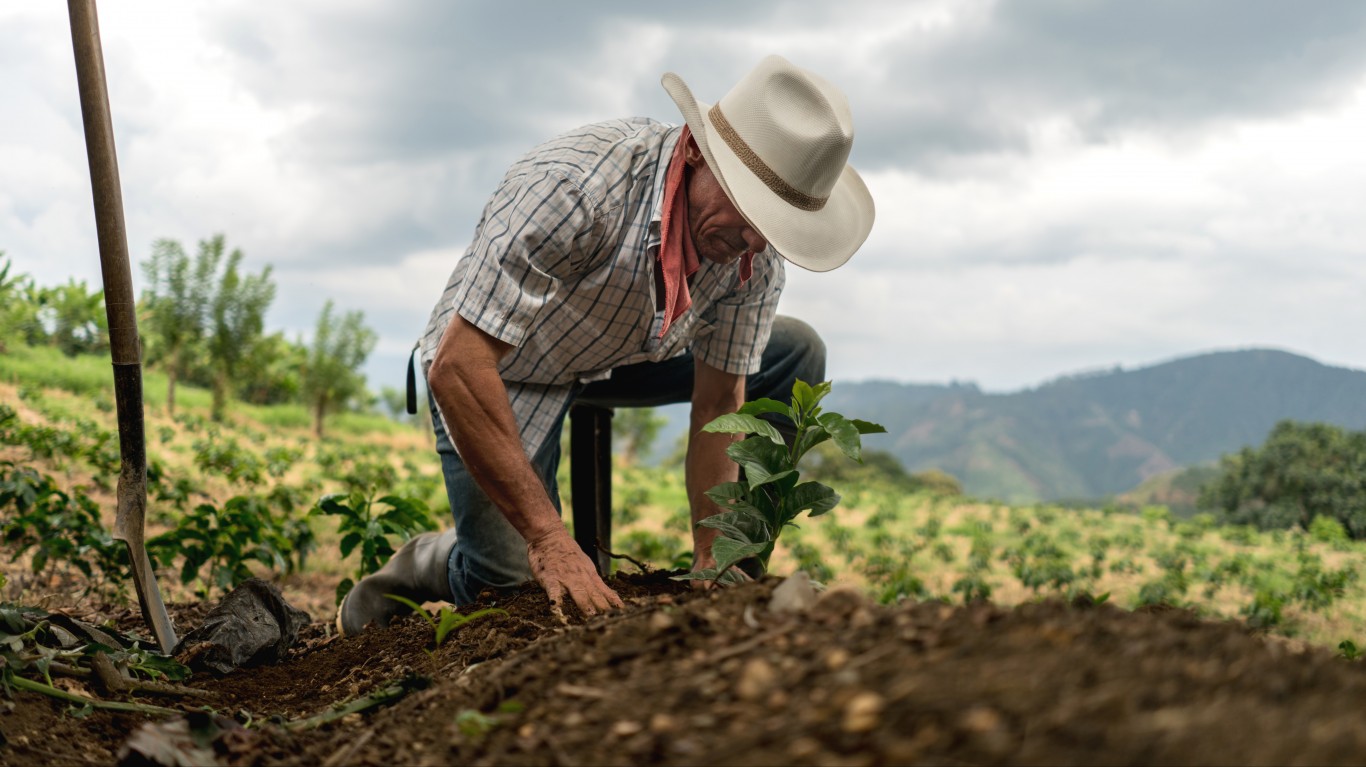
9. Coffee
Coffee production, which provides jobs for 100 million people around the world, is highly vulnerable to climate change. Because of the narrow genetic makeup of coffee beans, and thus their narrow climate sensitivity, and because coffee plantations have a 30 to 50 year lifespan, coffee production is difficult and slow to adaptation.
Studies indicate that coffee production may suffer in many regions of the world, particularly Brazil and Vietnam. Further, the few areas where land could become suitable for coffee production, mainly East Africa and some Asian island states, could not make up for the likely loss of suitable land for coffee growing, amounting to a reduction of about 50% of the currently available land by 2050.
[in-text-ad-2]
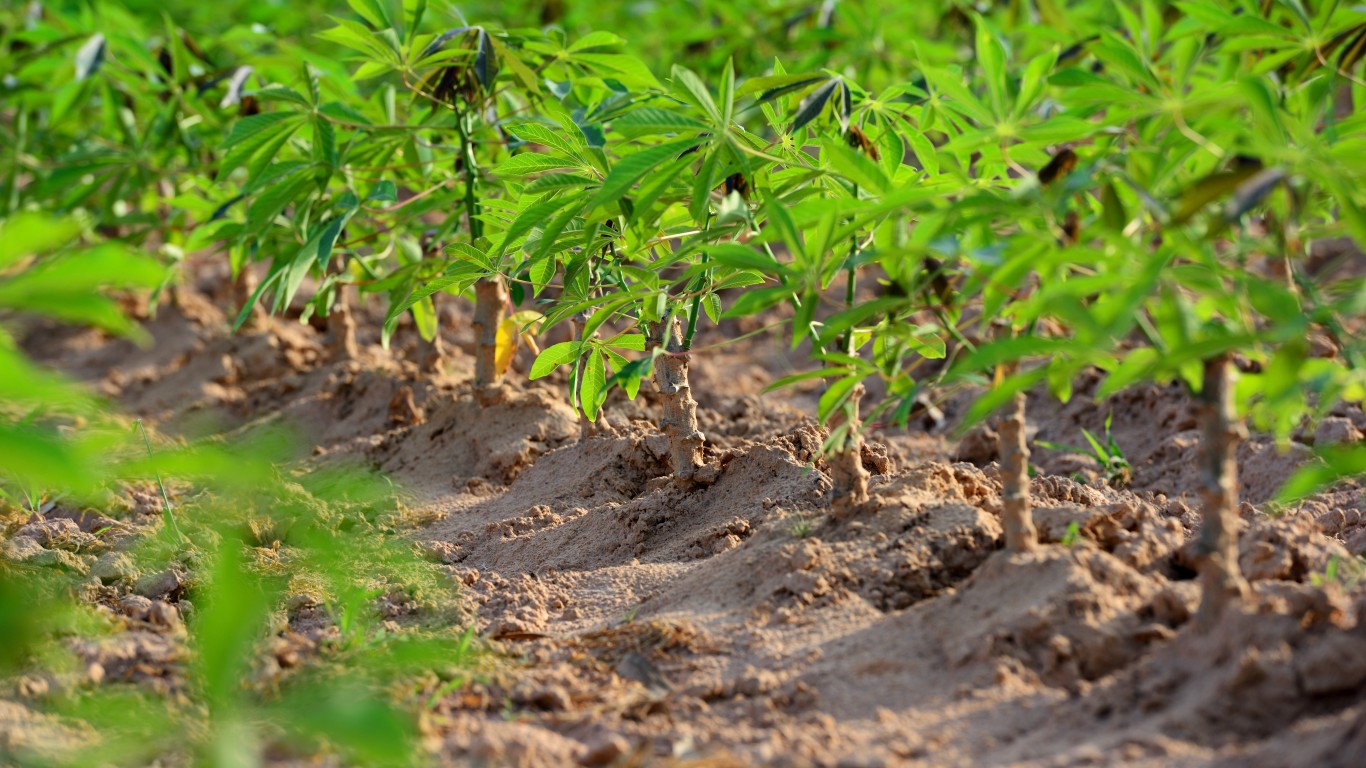
10. Cassava
Drought-resistant and easy to grow, cassava is one of the rare crops that can withstand climate change and thrive in warmer temperatures. Cassava is a staple of 800 million people living in tropical climes, and it is also used for animal feed and industrial manufacture. Scientists are encouraging the expansion of cassava production as a hopeful adaptation strategy, particularly for sub-Saharan Africa.
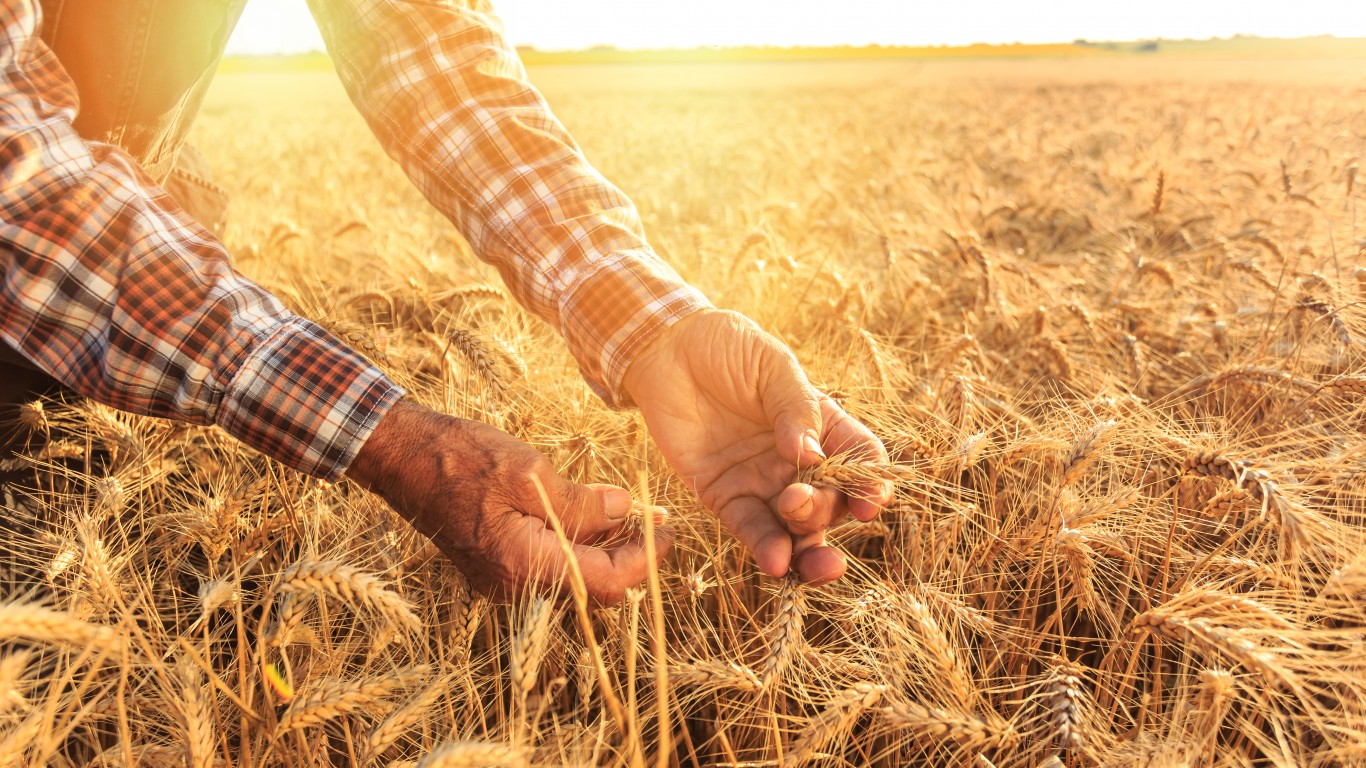
11. Oats
As with many commodity crops, oat crops can be damaged by extreme weather events, and yields are likely to decline as temperatures rise. There is also some evidence that stress from higher temperatures, atmospheric carbon dioxide, and low level drought conditions might lead to contamination of oat crops, specifically by mycotoxins associated with a fungus called Fusarium langsethiae, which render oats inedible.
[in-text-ad]
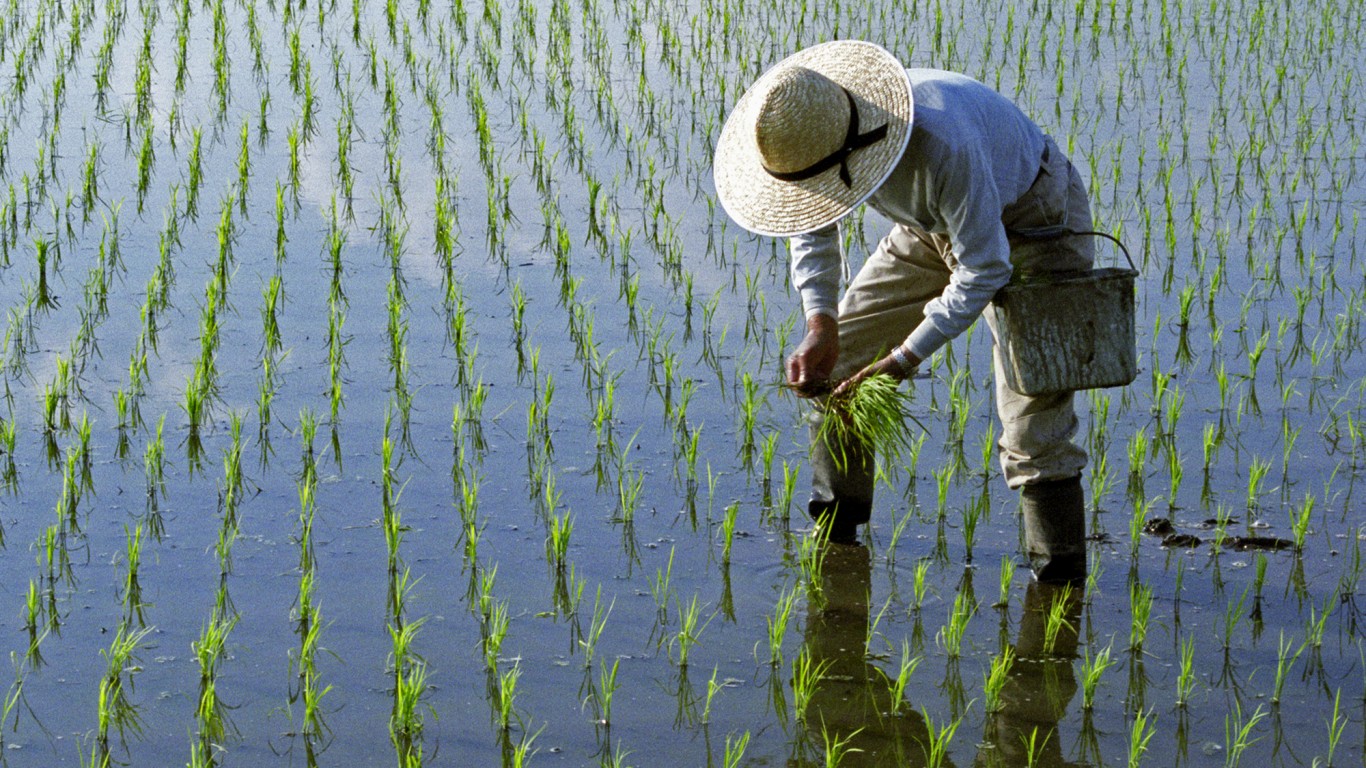
12. Rice
Half of the world’s population relies on rice for food security, and that security is threatened by climate change, particularly in tropical regions. Land and water resources required for rice production will be affected by rising temperatures, rainfall fluctuation, and rising sea levels, the risks of which include tidal waves and salinization. Global climate change is already credited with a reduction in worldwide rice production and yields, documented over the years 1974 and 2008.
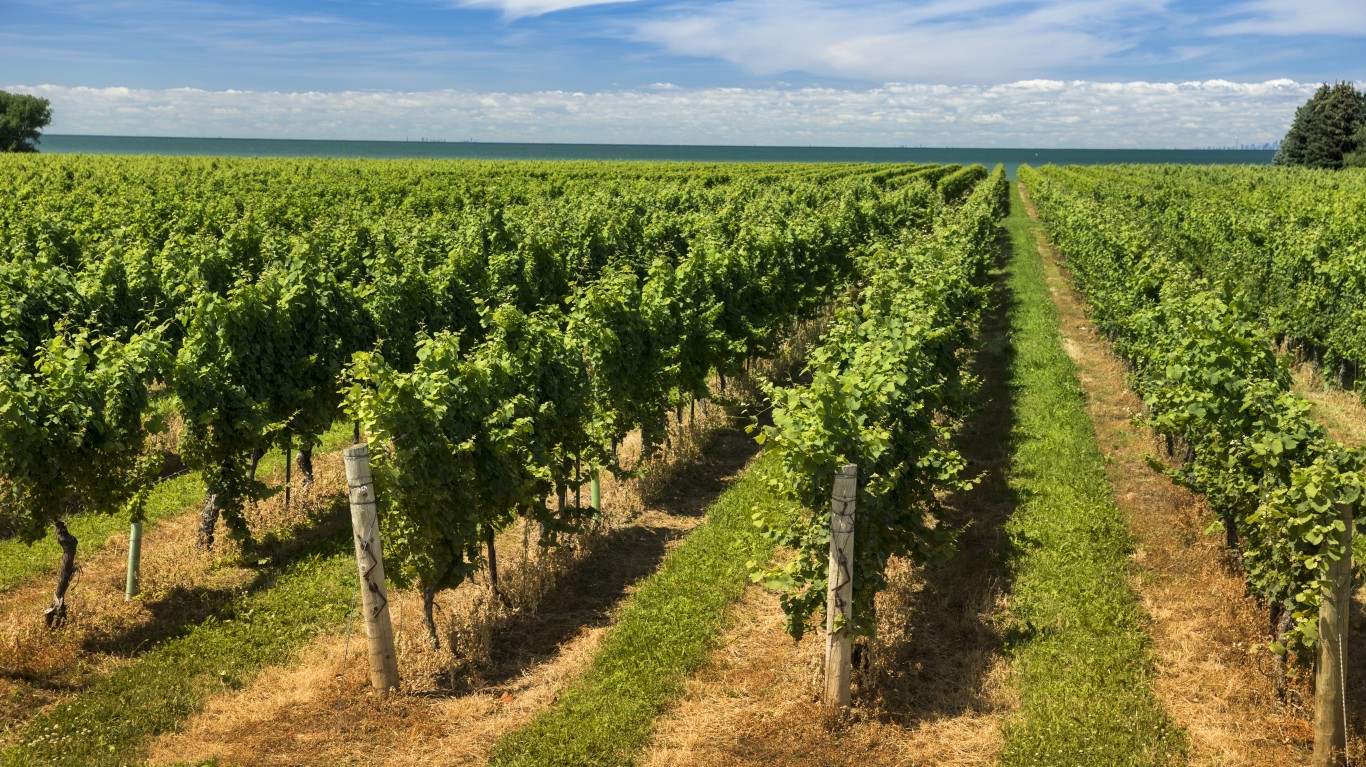
13. Champagne
Longer grape growing seasons and the resultant early harvests are causing reduced acidity — acidity gives freshness to the wines and allows champagne to age. Earlier springs also increase the likelihood of new growth being damaged by frost, and warmer nights in the summer promote the incidence of pests and diseases. Alarmed by the recent heat waves in France, growers and vintners in Champagne are experimenting with blending techniques and grape variations to preserve the classic quality and taste of their famous bubbly.
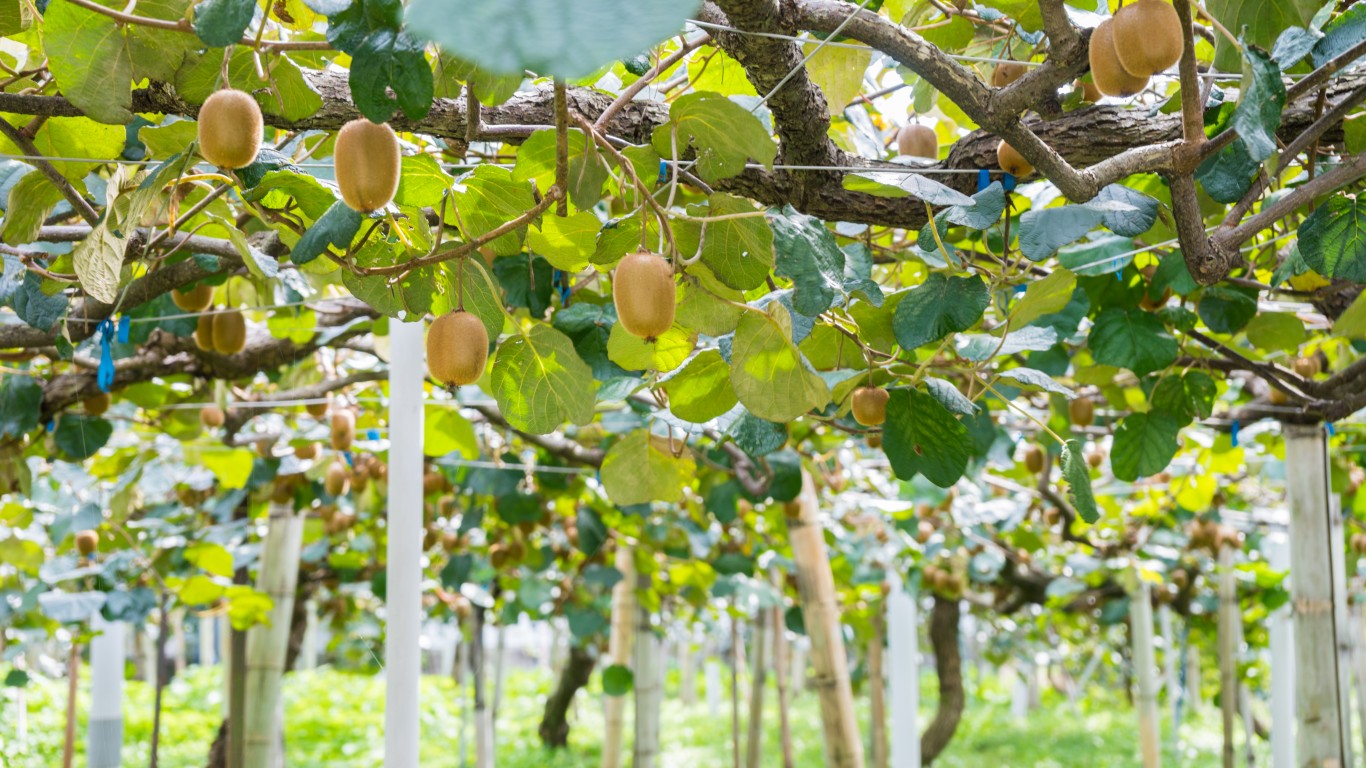
14. Kiwi
New Zealand’s concerns over kiwi fruit provide a lesson in the kinds of adaptation problems growers of certain crops will be experiencing in the future. The kiwi fruit requires cold temperatures to spur bud growth, but in one of New Zealand’s primary kiwi growing areas mother nature has not been up to the task as global temperatures are on the rise. To save the kiwi crops, growers have been using the chemical hydrogen cyanamide on the dormant fruit to promote bud development. Concerns over food safety are now causing a shift to other strategies such as research into genetic modifications in the fruit and a search for cropland more suitable to kiwi fruit requirements in a warming world.
[in-text-ad-2]
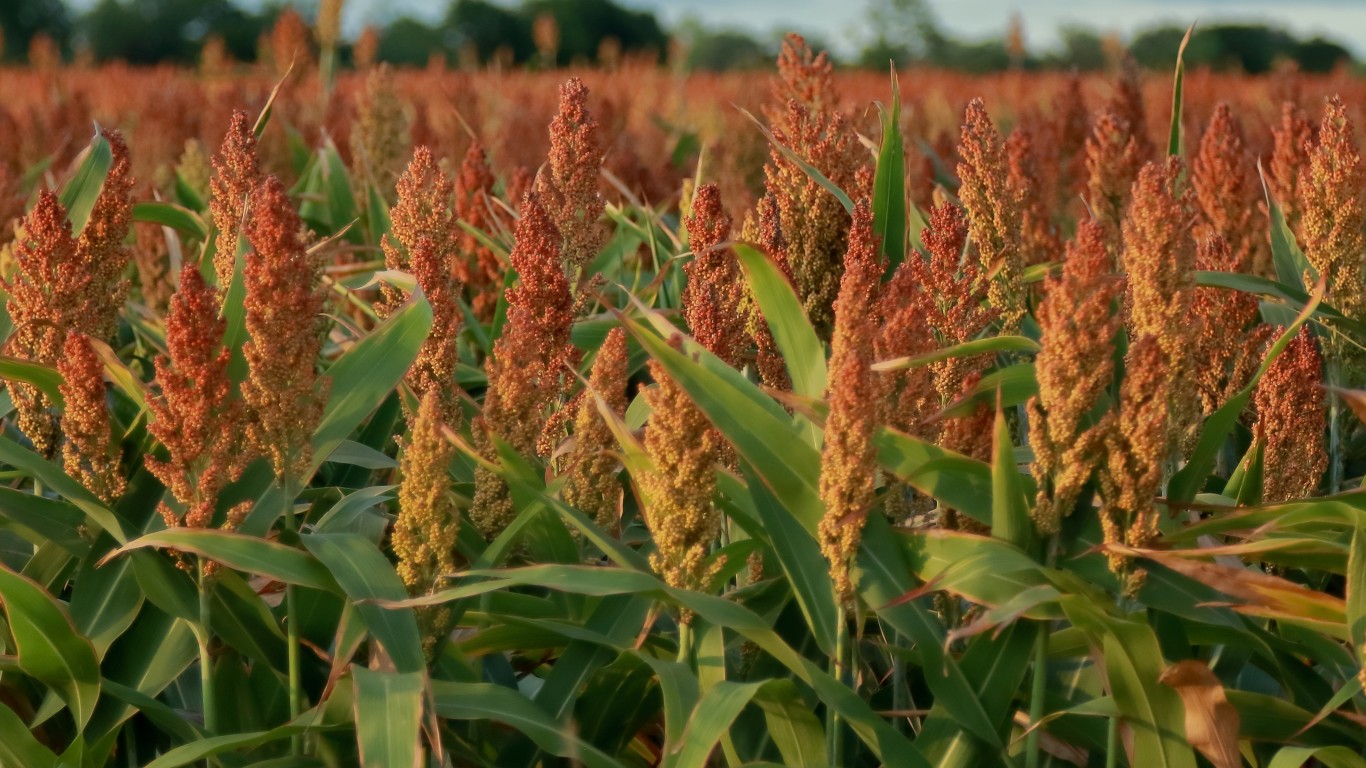
15. Sorghum
Sorghum is an important cereal crop, essential to the diet of half a billion people, most living in South Asia and sub-Saharan Africa, which are among the driest parts of the world. Sorghum is severely threatened by climate change, with scientists predicting a 10% drop in yields for every one degree increase in temperature. Indirect climate impacts, such as increased rates of plant moisture loss, could have even more serious consequences.
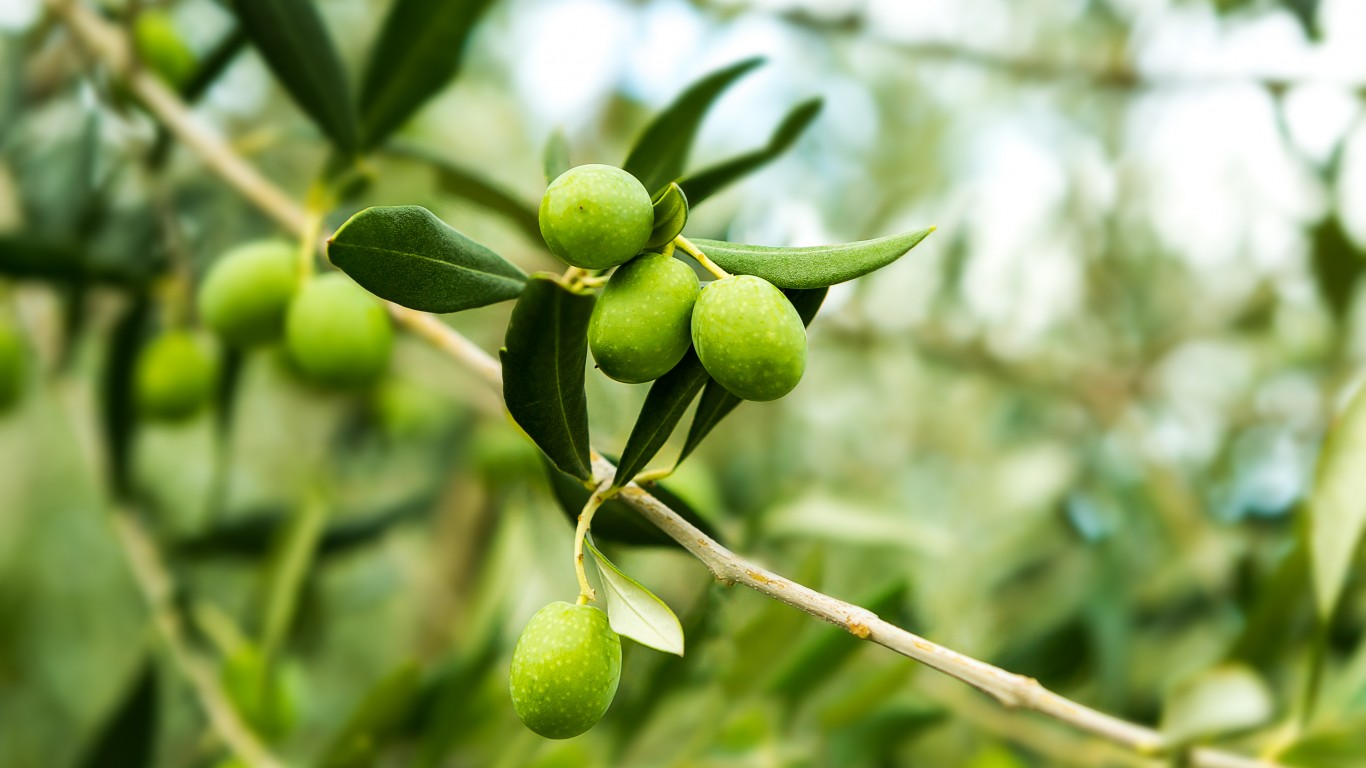
16. Olives
Despite their relative drought tolerance, olives are seriously threatened by changes in climate, primarily rising temperatures and lack of heavy rain required for crop development. In a primary growing area in Catalonia, Spain, researchers predict an end to olive oil production within 20 years. In Italy, extreme weather already resulted in a 57% drop in olive yields in 2018. And, in Israel there was a 17% drop that year. Worldwide, there was a 20% decline in olive production in the winter following the overheated summer of 2017.
[in-text-ad]
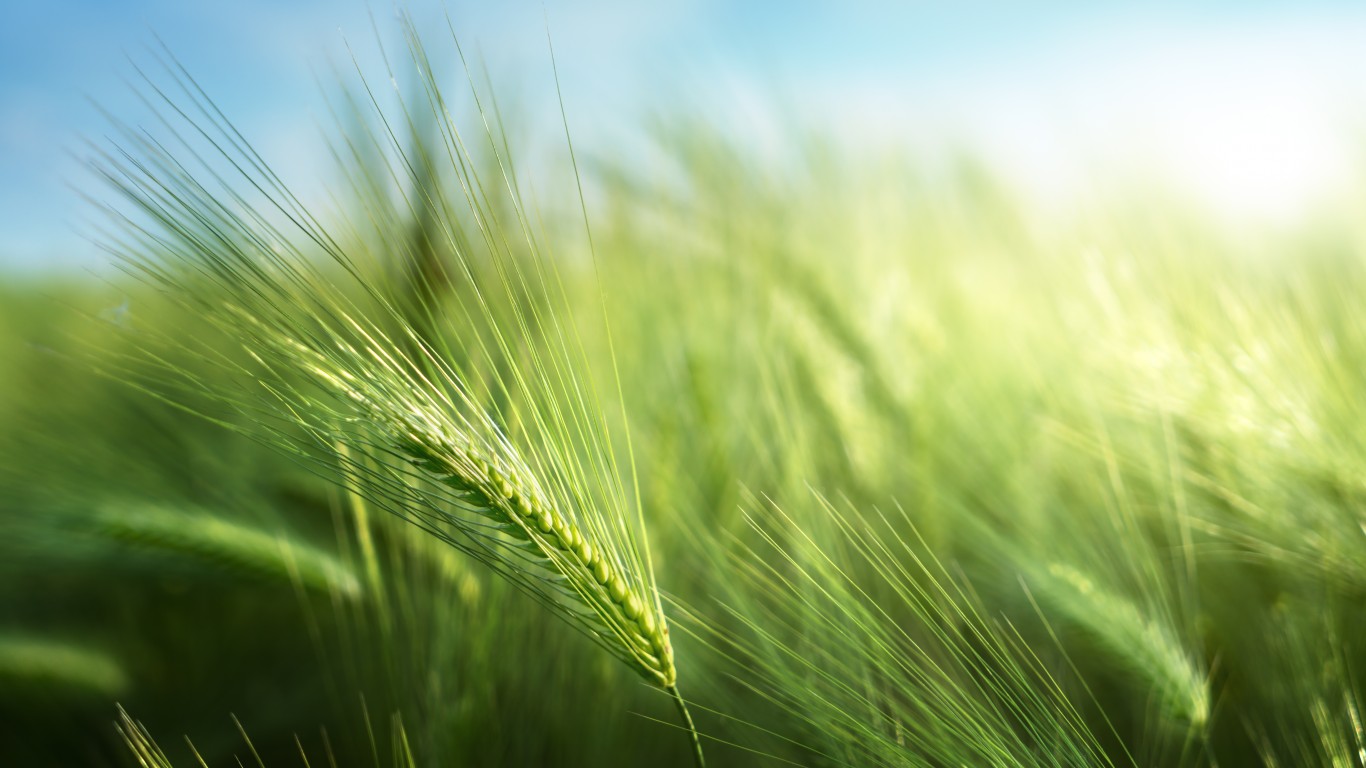
17. Barley
A British climate change economist with an interest in attracting attention to global warming studied the likely climate change impacts on barley and the resulting implications for beer production and costs. The research team analyzed the chances of major droughts and heat waves in areas where barley is grown and concluded that total barley yields would be reduced by 3% to 17% by 2099. According to the analysis, beer prices will be rising throughout the world, tripling in Ireland by the century’s end. Other studies show that climate change is already impacting barley production, with yields and production declining in the Pacific Islands, Africa, and, most notably, Europe.
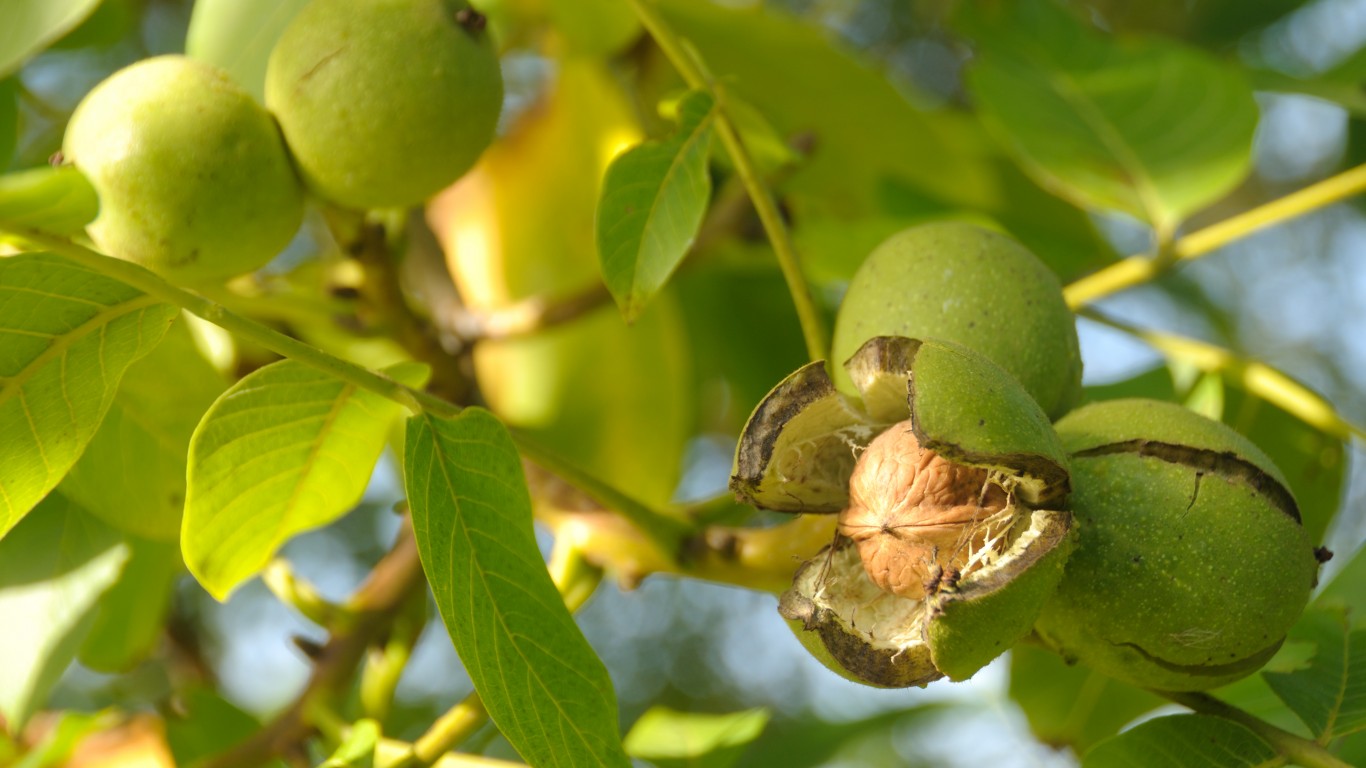
18. Walnuts
The United States is the second largest producer of walnuts, after China, and nearly 100% of U.S. walnut production is in California. A recent study of climate impacts on major California crops found that walnuts are the most vulnerable tree nut crop to rising temperatures. Walnuts require 400 to 1,500 of chill hours in the winter, depending on the variety, to stimulate spring growth. The study found that the number of chill hours has fallen by 2 a year over the past 105 years and continues to decline, threatening future drop yields. It is expected that walnut production will decline by 3% by 2050.
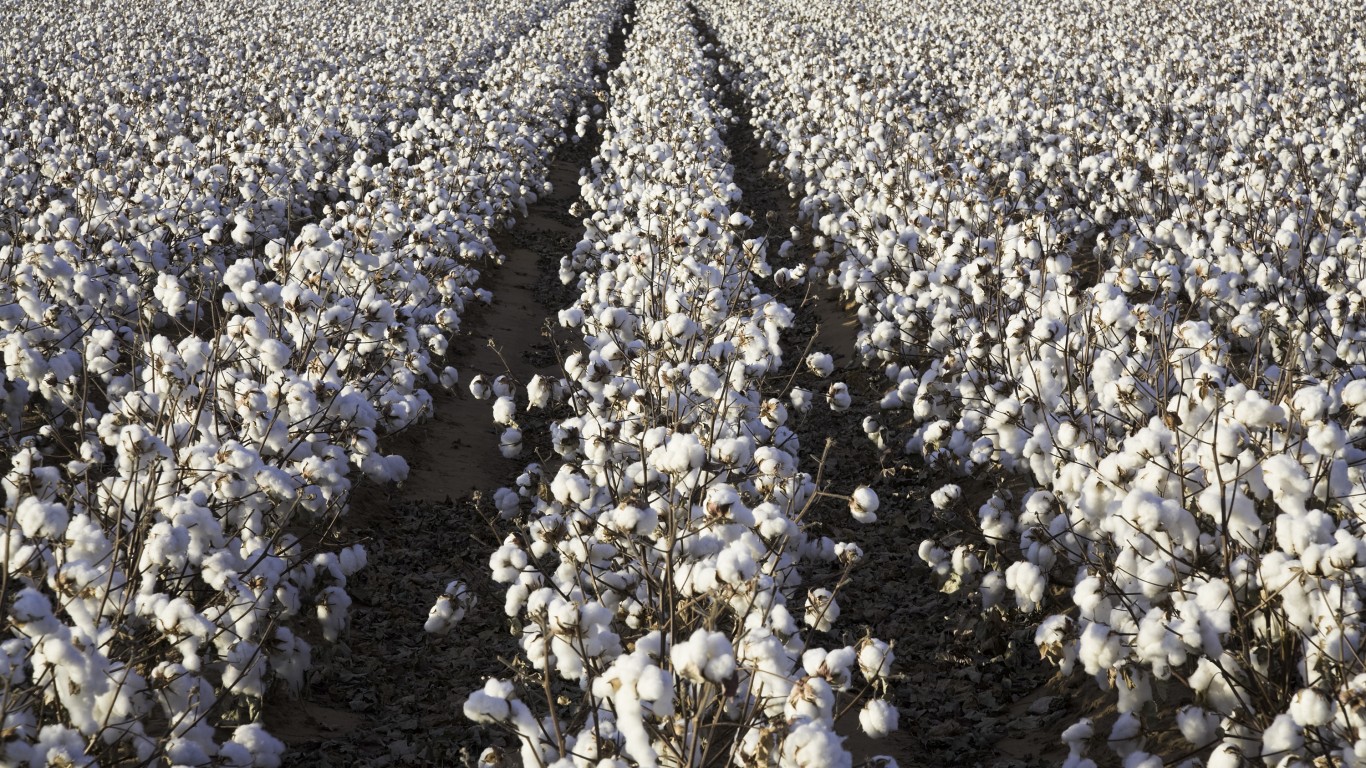
19. Cotton
Climate change impacts on cotton will vary greatly between growing regions. Cotton is heat-resistant and will benefit from increased temperatures in many parts of the world, including India, parts of Turkey and China, and the American Southeast. But other threats loom: pests, disease, water availability, and extreme weather. In particular, cotton production is threatened by reduced rainfall in China, Australia, Pakistan, and the American West.
[in-text-ad-2]
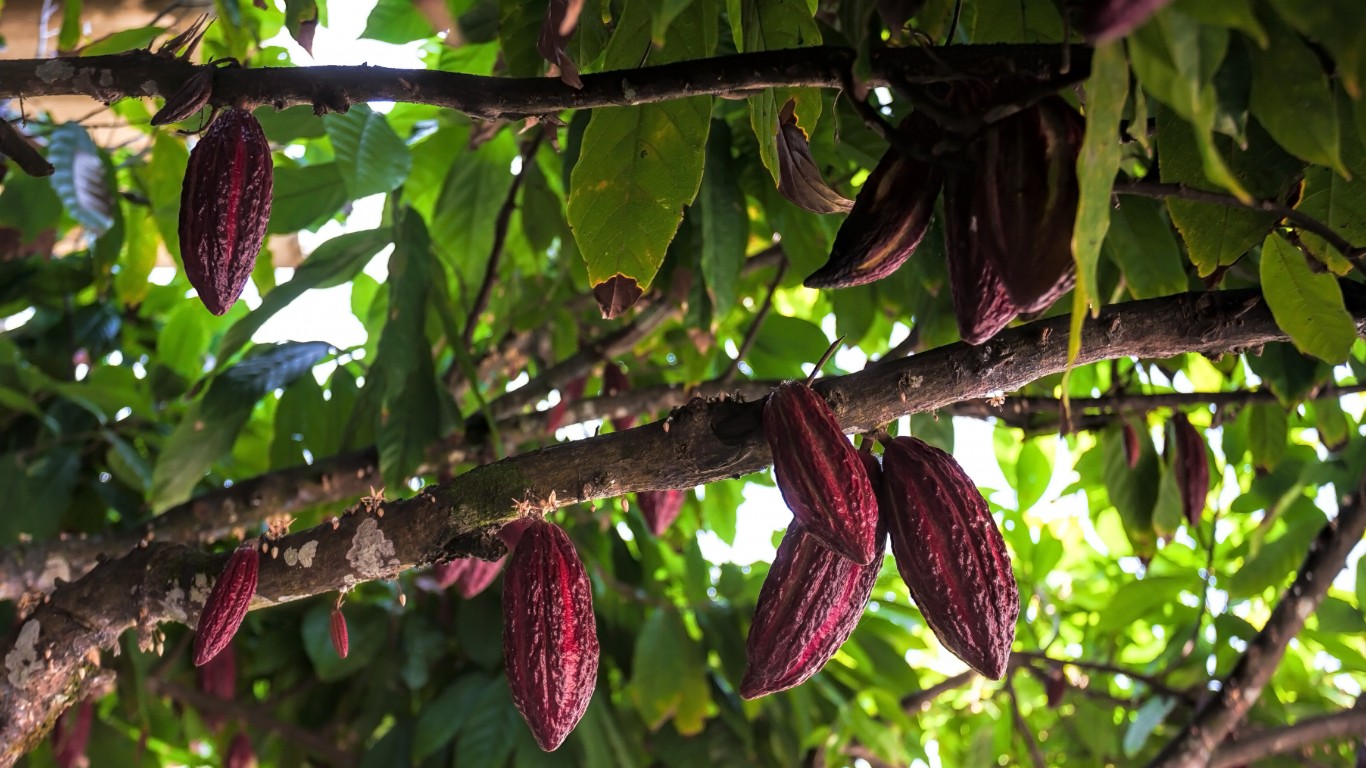
20. Cacao
The major threat to cacao production is not increased heat alone, but also the resulting loss of humidity that comes with reduced rainfall. In hot, dry air, cocoa plants lose needed moisture through evapotranspiration. For this reason, higher temperatures are threatening cocoa crops in West Africa but not in Malaysia. A recent study found that of the 294 cocoa-growing regions reviewed, 89.5% will become less suitable for cocoa production by 2050.
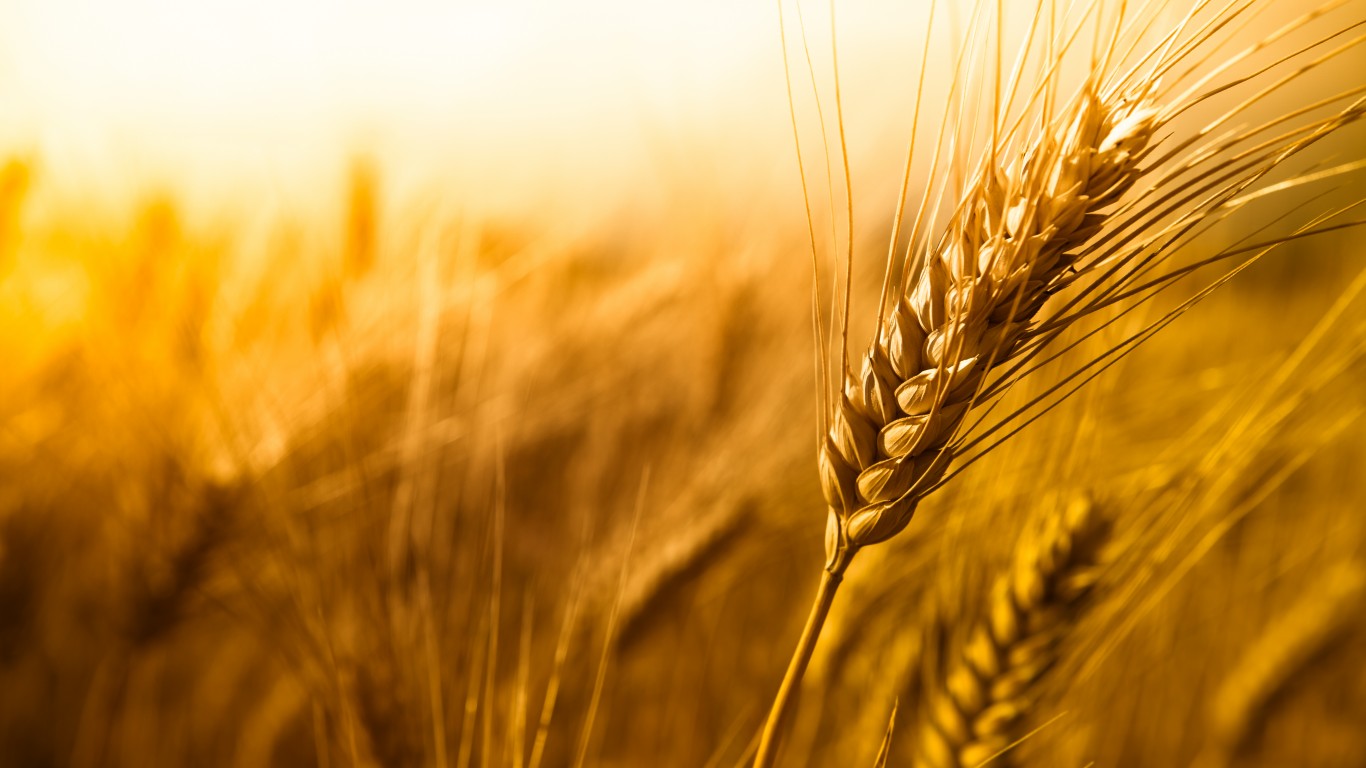
21. Wheat
Wheat production is highly susceptible to climate change. A recent study from Kansas State University concluded that, overall, worldwide yields will decrease by 6% for each degree Celsius increase in global average temperatures, and projected a 25% decline in wheat production over the coming decades due to extreme weather. Already there are impacts, with an approximate 1% drop in production in North and Central America, and a 2.5% to 6% drop in Europe attributed to climate change. At the same time, highlighting the variability of climate impacts, warming has increased production in North Africa by 12% and in eastern and central Asia by 4.5%.
[in-text-ad]
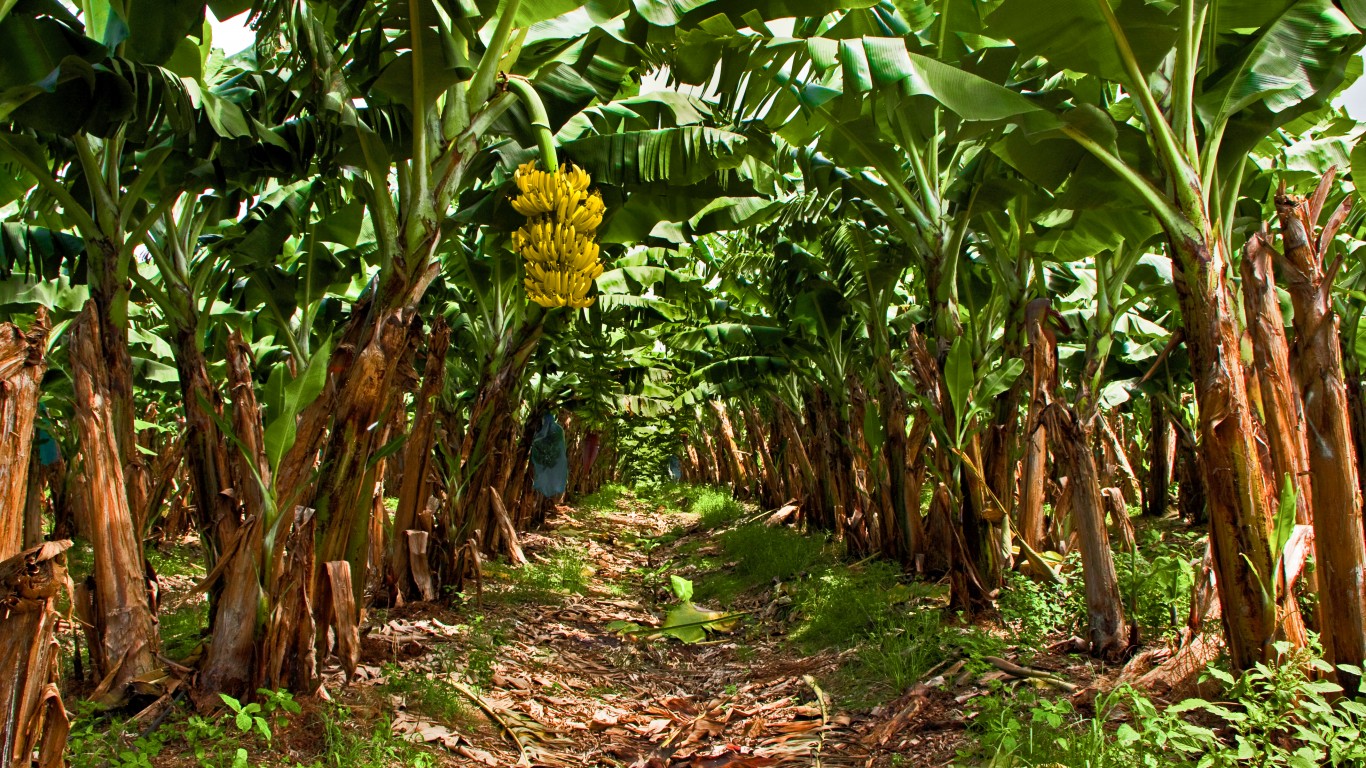
22. Bananas
Bananas, the world’s most important fruit crop from both a food source and economic perspective, have benefited from improved growing conditions attributed to climate change, with the 27 countries providing 86% of the world’s dessert bananas showing increased yields beginning in 1961. But a recent study from the University of Exeter predicts that this will change. By 2050, the positive impacts of climate change will begin to decline, and 10 of the largest banana-growing countries will experience declines in yield, including India, Brazil, Columbia, Guatemala, Costa Rica, Panama, and the Philippines.
Retirement planning doesn’t have to feel overwhelming. The key is finding expert guidance—and SmartAsset’s simple quiz makes it easier than ever for you to connect with a vetted financial advisor.
Here’s how it works:
Why wait? Start building the retirement you’ve always dreamed of. Click here to get started today!
Thank you for reading! Have some feedback for us?
Contact the 24/7 Wall St. editorial team.